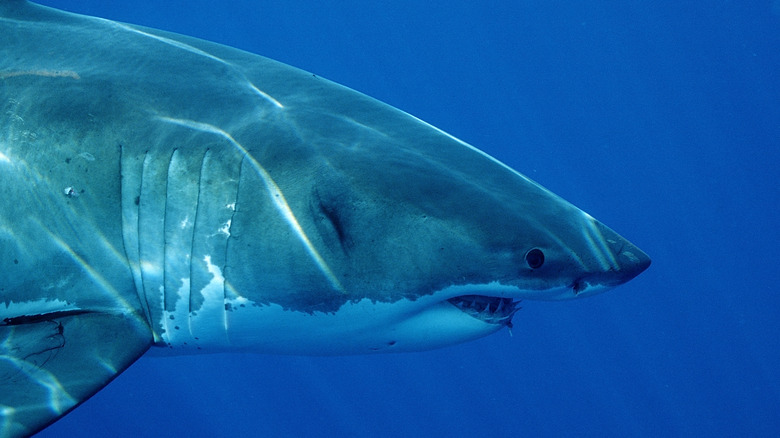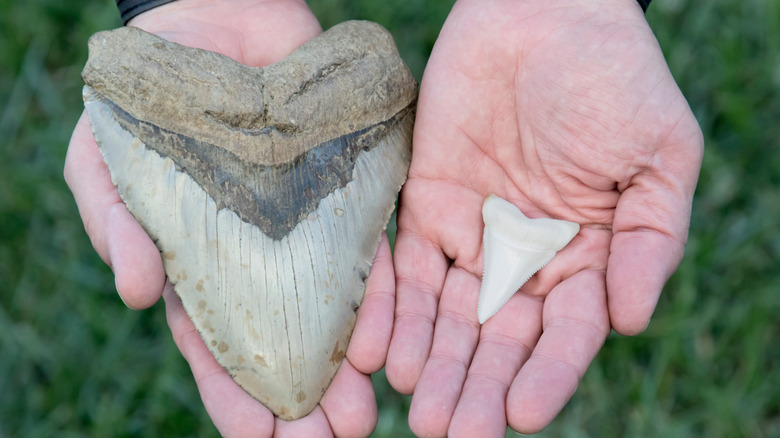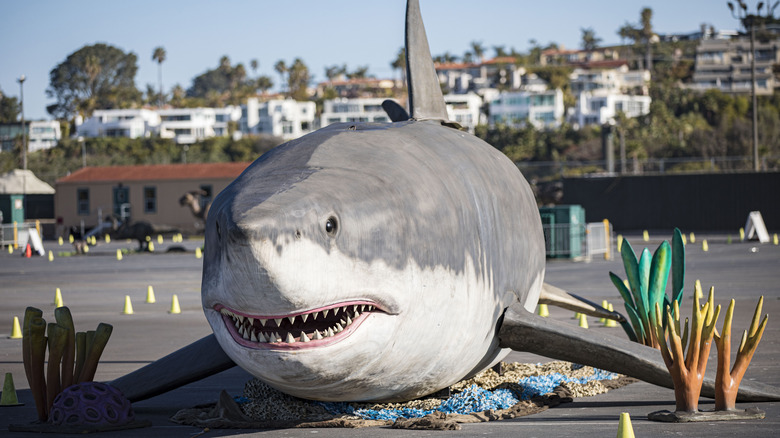Could Megalodon Sharks Exist Today?
Sharks come in all sizes — from the tiny dwarf lantern shark to the great white shark, one of the largest water predators you could ever find with an impressive weight of 2.5 tons or more. National Geographic describes them as "torpedo-shaped swimmers" that can reach up to 15 miles per hour. While humans aren't part of their diet, nearly half of the shark attacks that happen every year are the result of an encounter with a great white shark.
And that's not even the worst possible option. Take, for example, Deep Blue, a great white shark spotted off the coast of Mexico's Guadalupe Island. At 20 feet long, she's considered one of the largest sharks ever spotted in modern times. The average great white shark is scary enough at 11-15 feet, so Deep Blue is pretty gigantic, all things considered (via ABC 7 News).
Although sharks can be found almost anywhere, they prefer warmer water with temperatures of at least 59 degrees Fahrenheit, according to Mental Floss. This, coupled with heavy competition from other species and a shrinking habitat, could have played a role in the disappearance of the world's largest shark: the megalodon. But what if we could bring back the giant prehistoric creature? Could a megalodon even survive in today's world?
Big blue would be tiny next to a megalodon
The megalodon was the largest shark to ever live. According to the National History Museum, experts estimate megalodons could have reached a length of up to 59 feet — more than three times the size of Deep Blue. The truth, however, is that we don't know how big a megalodon was. The ferocious beasts went extinct around 3.6 million years ago, and a full skeleton has never been recovered. Still, paleontologists can more or less guess their size based on their teeth — some are 7 inches long.
Massive teeth not only tells us how big megalodons were but likely what they ate. It could also potentially explain why these massive prehistoric animals aren't around anymore. For starters, it would have taken a lot of calories to keep such a massive animal going, which means megalodon likely ate the largest things it could find in the ocean, including whales and other large marine life. So, if the availability of prey suddenly dwindled, it's at least possible that megalodon starved to death (per NHM).
According to scientists, a lot of the large prehistoric marine animals became extinct as the world started to cool down before entering the Ice Age. This could have killed all kinds of marine animals — even seabirds and turtles — affecting the food chain and eventually leaving megalodon with not enough to eat.
The modern world is not very megalodon-friendly
Lucky for us, the Ice Age brought on additional changes that made life unsustainable for giant marine beasts. As currents changed and glaciers expanded over the poles, the habitat of megalodon became smaller and smaller. Some marine life, including certain species of whales, could have potentially migrated toward colder waters, leaving the megalodon behind with little to eat. Over time, rain, wind, and continent shifting resulted in the temperature dropping about 27 degrees Fahrenheit — making life for the megalodon much more difficult (per ReefQuest Centre for Shark Research).
Finally, glacier formation actually took water away from the oceans, causing the sea level to drop over 600 feet and eliminating coastal areas where the megalodon would've hunted and reproduced. A combination of poor access to food and a shrinking environment potentially led to extinction, according to the ReefQuest Centre for Shark Research.
While our planet is now warming up and the poles are melting, the modern world is no longer a sustainable place for megalodon sharks. Marine megafauna is almost nonexistent today and the remaining whale population is well-adapted for life in cooler waters. Warm ocean waters, where the megalodon would choose to live, could no longer provide enough food or proper coastal breeding grounds for a predator that size (via Fossil Guy).
Modern ocean predators (such as orcas and great white sharks) would also likely hunt the 12-foot megalodon pups, limiting the species' chances for survival, according to ReefQuest Centre for Shark Research.


